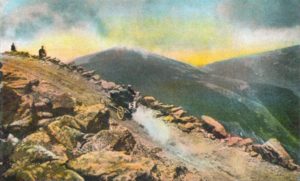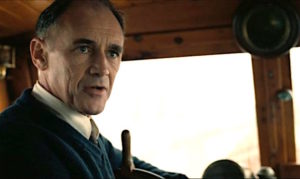I’ve been on the road too much of late to do much blogging. Now that Mrs. T and I are home again, I have time to do some catching-up before the fall theater season gets going in earnest. On Friday I announced the debut of Three on the Aisle, the new podcast about theater in America that Peter Marks, Elisabeth Vincentelli, and I launched last week. Here are a few other things that I want to share with you:
 • Mrs. T and I took two days off in between shows, went up to New Hampshire, and spent an afternoon driving up and down the Mount Washington Auto Road, a seven-and-a-half-mile-long road built in 1861 that goes all the way up to the summit of Mount Washington, whose altitude is 6,145 feet. Even in September, it’s cold and windy up there—sixty-seven miles an hour on the day we made the ascent—and the drive is, shall we say, a bit nerve-racking. A sign at the entrance to the road accurately describe it as “a steep, narrow mountain road without guardrails. If you have a fear of heights, you may not appreciate this driving experience.” That’s putting it softly, but we found the experience thrilling, though the two of us agreed when it was over that we’d settle for the guided tour on our next visit.
• Mrs. T and I took two days off in between shows, went up to New Hampshire, and spent an afternoon driving up and down the Mount Washington Auto Road, a seven-and-a-half-mile-long road built in 1861 that goes all the way up to the summit of Mount Washington, whose altitude is 6,145 feet. Even in September, it’s cold and windy up there—sixty-seven miles an hour on the day we made the ascent—and the drive is, shall we say, a bit nerve-racking. A sign at the entrance to the road accurately describe it as “a steep, narrow mountain road without guardrails. If you have a fear of heights, you may not appreciate this driving experience.” That’s putting it softly, but we found the experience thrilling, though the two of us agreed when it was over that we’d settle for the guided tour on our next visit.
 • We also made time to see a new movie, Dunkirk, from which we came away with sharply mixed feelings. It’s a technically impressive piece of work, and Mark Rylance gives a noteworthy performance, but the film as a whole struck me as little more than an unintelligent exercise in pure, context-free sensation, the real-life counterpart of the “feelies” that Aldous Huxley portrayed in Brave New World. As such, it’s a perfectly logical extension of the tendencies in modern big-budget filmmaking that can be traced all the way back to Jaws.
• We also made time to see a new movie, Dunkirk, from which we came away with sharply mixed feelings. It’s a technically impressive piece of work, and Mark Rylance gives a noteworthy performance, but the film as a whole struck me as little more than an unintelligent exercise in pure, context-free sensation, the real-life counterpart of the “feelies” that Aldous Huxley portrayed in Brave New World. As such, it’s a perfectly logical extension of the tendencies in modern big-budget filmmaking that can be traced all the way back to Jaws.
It also reminded me of what G.K. Chesterton said to the American friends who showed him for the first time the lights of Broadway:
I had looked, not without joy, at that long kaleidoscope of coloured lights arranged in large letters and sprawling trade-marks, advertising everything, from pork to pianos, through the agency of the two most vivid and most mystical of the gifts of God; colour and fire. I said to them, in my simplicity, “What a glorious garden of wonders this would be, to any who was lucky enough to be unable to read.”
We still haven’t seen The Big Sick, but we’re planning to fix that in the next day or two. Watch this space for details.
 • I was tickled by a photo sent to me by a friend who found it in a newspaper interview with Martin Amis. The photo shows Amis sitting in front of one of his bookcases. If you look closely, you can see The Skeptic, my H.L. Mencken biography, on the bottom shelf, right above Amis’ right knee. I hope he liked it!
• I was tickled by a photo sent to me by a friend who found it in a newspaper interview with Martin Amis. The photo shows Amis sitting in front of one of his bookcases. If you look closely, you can see The Skeptic, my H.L. Mencken biography, on the bottom shelf, right above Amis’ right knee. I hope he liked it!
• I kept a close eye from a distance at Hurricanes Harvey and Irma, both of which briefly threatened to affect my life as a playwright.
The Alley Theatre, which is producing Satchmo at the Waldorf this season, was hit hard by Harvey, which flooded the company’s downstairs performance space, forcing the Alley to resechedule its season. Satchmo will now be running there from February 23 to March 18.
As for Billy and Me, my new play, it will be premiered by Palm Beach Dramaworks, whose downtown theater was briefly threatened by similar devastation. Fortunately, Irma changed course at the last minute, the theater remained unscathed, and Billy and Me is set to open on schedule on December 8.
• Speaking of Satchmo at the Waldorf and its celebrated subject, I recently read an interview with Bill Frisell, the great jazz guitarist. Asked to recommend books for “someone who wants to learn more about music,” Frisell mentioned Pops, my Louis Armstrong biography: “Armstrong was such an amazing guy, and this book does him justice.” I’m proud of that.


